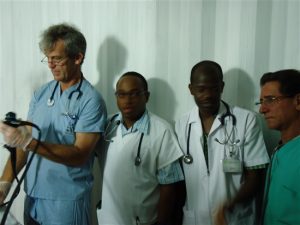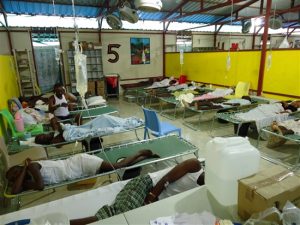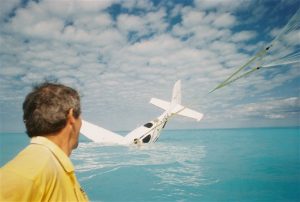In Memoriam: Brig. Gen. Max McLaughlin, M.D.
We are saddened to share the passing of Mobile physician Max V. McLaughlin. Known as Dr. Max to many, he passed away peacefully in his sleep on Monday, Sept. 10, 2018. He is survived by his wife, Nikki, his children Victor, Anne and Lauren, and his granddaughter Savannah. He leaves a legacy of achievement across Alabama, and his love of this state showed in his dedication to improving the lives of Alabamians from his personal relationships to statewide influence.
Early Life
Dr. Max was born in 1928 to Dr. James D. McLaughlin (1880-1953) and Alma Dovie Whigham McLaughlin (1890-1983) in the tiny town of Blue Springs, Alabama. He was the seventh of eight children, six boys and two girls. Stories of his childhood paint a picture of a funny, clever, and social young man that set the stage for the friends and accomplishments of his adult years. In 1946 he presented a calf he brought by plane to President Harry Truman on the White House lawn in his role as president of the Alabama Future Farmers of America.
Military Career
In 1946 he joined the Army during WWII, becoming a paratrooper in the 11th Airborne, a division known as “The Angels.” He was fond of saying that one’s third jump was the most frightening, as the newness and excitement wore off and the reality of mid-century parachuting technology set in. He was stationed at snowy Camp Haugen for the occupation of Japan and returned to Alabama in 1948 to go to college on the G.I. Bill, hitchhiking from Blue Springs to Tuscaloosa to start his life at the university.
After graduating from college and medical school, he joined the Alabama National Guard. He remained enlisted until age 60, when he retired at the rank of Brigadier General. In 1988, the armory formerly on Museum Drive was renamed to Fort Hardeman/McLaughlin, a fitting tribute to its most vocal advocate. He was known and respected as “The General” to many, with this title softened to the nickname “Gen-Gen” by his granddaughter.
Roll Tide
Dr. Max was fond of saying that he was a Bama fan twice-over, as he was a fan of Bear Bryant when the Bear played for Alabama in the 1930s as well as his more well-known role as Coach in the 1970s. Dr. Max was at Alabama from 1948 to 1952, continuing on to medical school to complete his M.D. in 1956. At Alabama, he joined the Phi Gamma Delta fraternity where he found lifetime friendships with Jack McWhirter and Robert McWhorter. His stories from this time included escapades with his friend Dick Bounds, working on the Rammer Jammer magazine and winning second place in the “World’s Ugliest Man” contest with a costume of raw meat and bones. He loved Alabama football and delighted in their win on the Saturday before he passed.
Medical Career
He started his practice on Dauphin Island Parkway in 1952 when he moved to Mobile. It is difficult to summarize the impact of Dr. Max’s 46-year career as he treated thousands, delivered hundreds of babies, and mentored many other physicians. For example, his own cardiologist had Dr. Max as a family doctor when he was a child and several of the nurses who took care of him used to be patients of his or used to work in his office. He often joked to his own children when they complained of a skinned knee that he “wasn’t on call,” but of course he was. When he retired in 1998 he was still making house calls for his patients, for which he was profiled in the Mobile Press-Register as one of the last doctors to do so. In the summer, he took mission trips to Guatemala to freely treat those in need, armed with only one Spanish phrase: “Dos cervezas, por favor.” His black, old-time medical bag was always present. He cared for his patients as people, and they responded in kind.
Personal Life
Dr. Max passed down independence (and stubbornness) to his children along with the desire to leave the world a better place, albeit with differences in opinion on how to best do so. His son Victor, currently practicing radiology in New York, was born to his first wife Sally, who preceded him in death along with their daughters Holly and Lucy. He was married to his current wife Nikki for forty-four years and lived most of that time in his home on Old Shell Road, curating a magnificent vegetable garden in the front yard and an equally magnificent compost heap in the back. They had two daughters, Anne and Lauren. Anne earned her Ph.D. at Georgia Tech and is a professor in the psychology department at North Carolina State University. Lauren holds a master’s degree in exercise physiology as well as raising Max’s precocious granddaughter, “Savi.” In Dr. Max’s later years, his dog Killer was a constant companion whether it was quail hunting in Baldwin County or riding in the pickup truck to the post office. We hope they are together again.
Medical Legacy
Over ninety-two percent of Alabama’s counties have a shortage of health care providers, particularly primary care physicians. This statistic has worsened as Alabama has grown and as medical students chose specialties other than family medicine. Max McLaughlin was a family doctor his entire career, giving him a dogged passion for improving access to primary care in underserved areas of the state. Over fifteen years ago, he began work with Wil Baker, Ph.D., and the Alabama Medical Education Consortium to help establish the Alabama College of Osteopathic Medicine (ACOM), a medical school dedicated to training family practitioners who commit to serving rural areas across Alabama. ACOM graduated its first class in 2017, sending 128 doctors to their residencies in the towns and cities that most needed them. That number is growing every year, resulting in the largest impact of any program in the state dedicated to increasing primary care providers. Dr. Max also remained active locally in the University of South Alabama, serving on their Board of Trustees, was on the ALAPAC Board of Directors, a state medical association committee encouraging physician involvement in legislative affairs, and was a former president of the Alumni Association of the Medical College of Alabama.
In closing, it is impossible to sum up ninety years of life in a few paragraphs. We miss him immeasurably and are grateful for this chance to share some of what made Max McLaughlin so unique.
Celebrating His Life
Memorial Service was held at St. Paul’s Episcopal Church on Old Shell Road on Thursday, Sept. 13 at 10:30 a.m. In lieu of flowers, please consider donating to the USA Children’s and Women’s Hospital Collins Marie Carr NICU Garden in honor of his late granddaughter, Collins. His family would like to thank the nursing staff in the cardiology unit at Springhill Memorial Hospital and the Springhill Rehabilitation and Senior Residence for their kindness and care and for treating Dr. Max with dignity.
Posted in: Members
Leave a Comment (0) →




